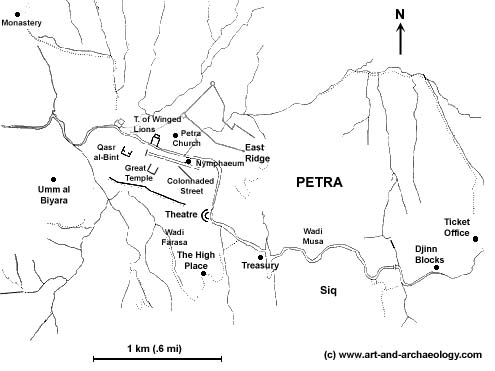The Nabataeans first come into prominence during
the Hellenistic Age. Originally a nomadic tribe from
Arabia, they settled in the land of Edom, grew rich from the
spice trade, and by the mid second century BC had established a trading
kingdom with its capital at Petra. At its height, between 100 BC
and 100 AD, the Nabataean Kingdom had expanded north to Bostra in southern Syria, west to the Negev and the Sinai, and south to Hegra and
the Red Sea. Although they were allies of Rome during this time, the Nabataeans' wealth and strategic location proved
irrisistable to the Romans, who in 106 AD incorporated the Nabataean Kingdom into Trajan's newly-created Province of Arabia.
The subsequent prosperity of Nabataea fluctuated along with
the other Eastern Roman provinces. Petra transformed itself into
a metropolitan city and bishopric see (residence) in
Byzantine times, but declined into insignificance during the Islamic
period, from the 7th century onwards, due to shifting patterns of trade and politics
attendant on the move of the Islamic capital from Damascus to Baghdad;
Petra remained essentially deserted for the next thousand years, except for the occasional pilgrim, crusader,
or Arab traveler who might happen to pass through the area, or the bedouin who made temporary dwellings in the city's caves and tombs.
The city was rediscovered by European explorers (Burckhardt, de Laborde) in the early 19th
century. By that time any local knowledge of the history of Petra had been long forgotten, and replaced by legend1.
The visitor to Petra today (2005) will see ruins from the Hellenistic, Roman, and Byzantine periods. Most spectacular and unique are the monumental tomb facades that are cut into pink
sandstone cliffs above the city's wadis (dry
river valleys). These family tombs were fashioned for the Nabataean elite – kings, royals, and the rich merchant-nobility. Behind their elaborate facades, little remains but a large and empty
room with a few small chambers (loculi) cut into the wall,
in which the deceased were interred. The burials themselves have long been robbed out,
and their chamber roofs blackened by nomadic fires.
The tomb facades of Petra are greatly admired because
of the beautiful colors in their underlying rock, which
range from the rose-pink of dawn to the golden glow
of the setting sun. However, these monuments had a very different appearance in antiquity;
they were plastered and painted in brightly-colored white, yellow, and red stucco.
Below its monumental tombs, the city of Petra
was approached from the narrow and easily-defensible Wadi Musa
to the east. In ancient times, Petra
was a green and vibrant place, watered by the seasonal
rains that fell down the cliffs and into the desert valley. Control
of this water was essential for life, and the Nabataeans mastered it
by expert feats of hydraulic engineering: wells, channels, and
cisterns. The remnants of Nabataean water-works are still visible
today; many have even been rebuilt, in the late 20th and early 21st
century, in order to protect the city's ruins from the rains that still wash down the slopes of the wadis.
Although the Nabataeans were fully literate2,
we do not have very much of their writing.
Some dedications and inscriptions are still readable, although
many of these have been lost. Two important caches of personal
documents – the Babatha archive from Nahal Hever, and the carbonized papyri from Petra Church – deal with
the legal and economic affairs of particular persons. Beyond that, we have little
or nothing from the Nabataeans about their history, literature, or
religion.
High in the mountains, above the cliffs of the wadis, are
ancient High Places whose altars were dedicated, in accordance
with usual Semitic practice, to the local gods of the Nabateans.
Still under worship in Roman times,
these remnants of an earlier past recall, in their roof-of-the-world scenery and numinous atmosphere, a primeval and sacred geography.
1Thus the fanciful, contemporary Arabic names of Petra's
monuments have little to do with the real
function of these ancient buildings: the Khazneh is not a treasury, the Deir is not a monastery, and so on.
2Nabatean script derives from Aramaic, and
eventually evolved into Modern Arabic. Many
inhabitants were bilingual in Nabataean and Greek.

